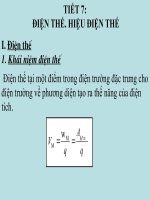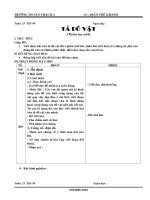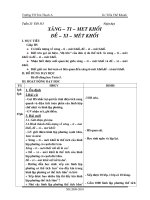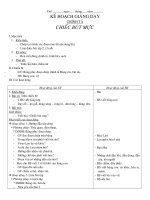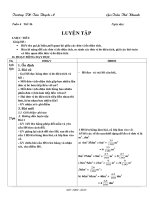Marketing management topic 5 craffting the brand positioning
Bạn đang xem bản rút gọn của tài liệu. Xem và tải ngay bản đầy đủ của tài liệu tại đây (183.91 KB, 20 trang )
MARKETING MANAGEMENT
Topic 5
Crafting the Brand
Positioning
Kotler
Keller
Chapter Questions
How can a firm choose and communicate
an effective positioning in the market?
How are brands differentiated?
What marketing strategies are appropriate
at each stage of the product life cycle?
What are the implications of market
evolution for marketing strategies?
10-2
Marketing Strategy
Segmentation
Targeting
Positioning
10-3
Positioning
Act of designing the company’s
offering and image to occupy
a distinctive place in the mind of
the target market.
10-4
Value Propositions
Perdue Chicken
More
tender golden chicken at a moderate
premium price
Domino’s
A good
hot pizza, delivered to your door within
30 minutes of ordering, at a moderate price
10-5
Writing a Positioning Statement
Mountain Dew: To young, active
soft-drink consumers who have
little time for sleep, Mountain Dew
is the soft drink that gives you
more energy than any other brand
because it has the
highest level of caffeine.
10-6
Defining Associations
Points-of-difference
(PODs)
Attributes or benefits
consumers strongly
associate with a brand,
positively evaluate, and
believe they could not
find to the same extent
with a competitive brand
Points-of-parity (POPs)
Associations that are
not necessarily
unique to the brand
but may be shared
with other brands
10-7
Conveying Category
Membership
Announcing category benefits
Comparing to exemplars
Relying on the product descriptor
10-8
Consumer Desirability Criteria for
PODs
Relevance
Distinctiveness
Believability
10-9
Deliverability Criteria for PODs
Feasibility
Communicability
Sustainability
10-10
Examples of Negatively Correlated
Attributes and Benefits
Low-price vs. High
quality
Taste vs. Low calories
Nutritious vs. Good
tasting
Efficacious vs. Mild
Powerful vs. Safe
Strong vs. Refined
Ubiquitous vs.
Exclusive
Varied vs. Simple
10-11
Addressing Negatively Correlated
PODs and POPs
Present separately
Leverage equity of another entity
Redefine the relationship
10-12
Differentiation Strategies
Product
Personnel
Channel
Image
10-13
Product Differentiation
Product form
Features
Performance
Conformance
Durability
Reliability
Reparability
Style
Design
Ordering ease
Delivery
Installation
Customer training
Customer consulting
Maintenance
10-14
Identity and Image
Identity:
The way a
company aims to
identify or
position itself
Image:
The way the
public perceives
the company or its
products
10-15
Product Life Cycle
Introduction
Growth
Maturity
Decline
10-16
Facts about Life Cycles
Products have a limited life.
Product sales pass through distinct
stages.
Profits rise and fall at different stages.
Products require different marketing,
financial, manufacturing, purchasing, and
human resource strategies in each stage.
10-17
Marketing Program Modifications
Prices
Distribution
Advertising
Sales promotion
Services
10-18
Market Evolution Stages
Emergence
Growth
Maturity
Decline
10-19
Emerging Markets
Latent
Single-niche
Multiple-niche
Mass-market
10-20
